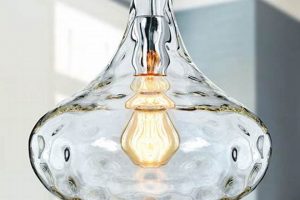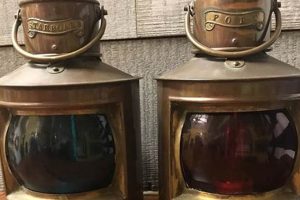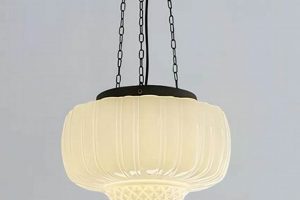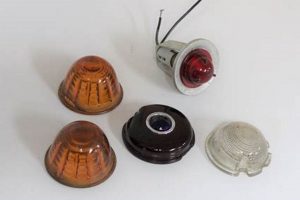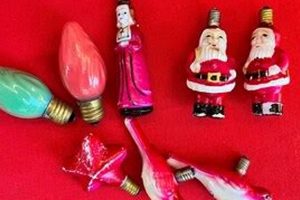These decorative lighting devices, originating from the early to mid-20th century, served the practical function of providing a dim illumination during nighttime hours. Examples include ceramic figures housing a small bulb, glass shades with intricate designs, and metal constructs shaped into familiar objects, all designed to plug directly into an electrical outlet.
Their appeal stems from a combination of functionality and nostalgia. These pieces offer a soft glow for safety and comfort, while also acting as collectible items reflecting past aesthetic trends and manufacturing techniques. The historical context reveals a shift in domestic electricity use and evolving design sensibilities within the home.
The subsequent discussion will address the varied forms these lighting objects took, the materials commonly used in their construction, their value in the collectors’ market, and the safety considerations when handling and using electrical items of advanced age.
Tips for Evaluating and Maintaining Vintage Night Lights
The following guidelines are designed to assist in the responsible acquisition, assessment, and upkeep of these antique electrical items. Adherence to these recommendations promotes safety and preservation.
Tip 1: Inspect Wiring Diligently: Prior to operation, examine the electrical cord for fraying, cracking, or exposed wires. Deteriorated wiring poses a significant fire hazard and should be replaced by a qualified electrician.
Tip 2: Assess the Plug Integrity: Ensure the plug prongs are securely attached and free from corrosion. A loose or damaged plug can overheat and cause electrical shorts.
Tip 3: Verify Material Composition: Identify the materials used in the device’s construction. Older plastics may become brittle and prone to cracking. Certain painted surfaces may contain lead. Handle with care and avoid ingestion.
Tip 4: Confirm Bulb Compatibility: Use only bulbs of the wattage specified for the fixture. Exceeding the recommended wattage can generate excessive heat, damaging the device or creating a fire risk.
Tip 5: Consider Professional Restoration: For valuable or significantly damaged pieces, professional restoration is recommended. Experts possess the knowledge and tools to safely repair electrical components and preserve the item’s aesthetic value.
Tip 6: Implement Safe Display Practices: When displaying, keep these items away from flammable materials and areas prone to moisture. Secure placement prevents accidental falls and damage.
These recommendations emphasize the importance of careful inspection and responsible maintenance. By prioritizing safety and preservation, enthusiasts can enjoy the aesthetic and historical value of these items for years to come.
The subsequent section will address the identification of specific manufacturers and design styles prominent in the history of these electric novelties.
1. Era of Manufacture
The era in which a night light was manufactured significantly dictates its characteristics, influencing materials, design, and safety standards. The technological advancements and cultural aesthetics of a given period invariably shaped the production of these domestic illuminations. For instance, early 20th-century examples frequently employed Bakelite, a then-innovative plastic, molded into geometric shapes reflecting the Art Deco movement. These items, however, often lack modern safety features, presenting potential hazards. Similarly, mid-century models, characterized by atomic-inspired designs and vibrant colors, may utilize less durable plastics susceptible to degradation over time. Identifying the manufacturing era is therefore crucial for assessing the object’s historical significance, material composition, and operational safety.
The practical significance of understanding the era of manufacture extends beyond mere identification. Knowing the manufacturing period informs appropriate conservation strategies. Items produced before the widespread adoption of grounded electrical systems require careful evaluation and potential rewiring to mitigate shock risks. The presence of specific materials, such as asbestos in certain early models, necessitates specialized handling and disposal procedures. Furthermore, the period of origin directly impacts the item’s value within the collectors’ market, with rarer or more aesthetically significant examples commanding higher prices. For example, a figural night light produced during the World War II era, due to material shortages and wartime constraints, may be scarcer than similar items from subsequent decades.
In summary, the manufacturing era is a foundational element in understanding a vintage night light. It affects safety, material integrity, design, and ultimately, value. Ignoring this factor can lead to inappropriate handling, damage, or even hazardous situations. Therefore, careful research and identification of the production era are essential first steps in appreciating and preserving these historical artifacts of domestic lighting.
2. Materials Employed
The materials utilized in the construction of these vintage lighting devices are fundamental to their aesthetic, durability, and safety. The choice of materials reflects the technological capabilities and design sensibilities prevalent during their respective periods of manufacture, significantly influencing their long-term preservation.
- Glass Composition
Glass, frequently employed for shades and decorative elements, exhibits considerable variation in composition. Pressed glass, characterized by intricate patterns, was common in earlier models, while later examples often feature blown glass with smoother surfaces. The type of glass affects its fragility, resistance to heat, and ability to diffuse light. Notably, some colored glass formulations contain heavy metals, requiring cautious handling.
- Metal Components
Metal bases, frames, and electrical contacts were essential structural components. Brass, steel, and cast iron were commonly utilized, each exhibiting distinct properties regarding corrosion resistance and structural integrity. The presence of rust or oxidation indicates potential structural weaknesses and necessitates careful assessment prior to use.
- Plastic Varieties
The introduction of plastics revolutionized the design and manufacturing of these devices. Bakelite, a thermosetting resin, was prominent in early to mid-20th-century models, offering durability and moldability. However, Bakelite can become brittle and discolored with age. Later models incorporated thermoplastic polymers, such as polystyrene, which are lighter but more susceptible to cracking and degradation from ultraviolet (UV) exposure.
- Wiring and Insulation
The materials used for wiring and insulation are critical for electrical safety. Early wiring often employed rubber insulation, which degrades over time, leading to cracking and exposure of conductors. Fabric-covered wiring, while aesthetically appealing, can also deteriorate and pose a fire hazard. Modern replacements utilizing thermoplastic insulation are generally safer and more durable.
In conclusion, the selection of materials in their construction is a defining characteristic, directly impacting their longevity, safety, and historical significance. Thorough examination of these materials is crucial for responsible acquisition, preservation, and operation of these antique lighting objects.
3. Design Aesthetics
Design aesthetics significantly influence the appeal and historical value of vintage night lights. The stylistic choices made during their production, from form and color to materials and ornamentation, reflect prevailing artistic movements and cultural preferences. These elements not only contribute to the object’s visual attractiveness but also serve as markers of their time, offering insight into past design trends. For example, a night light featuring streamlined shapes and geometric patterns is likely indicative of the Art Deco era, while one incorporating organic forms and muted colors might suggest a mid-century modern influence. The relationship is one of cause and effect; the design aesthetic of the period directly impacts the object’s form.
The importance of design aesthetics extends beyond mere visual appeal. The stylistic elements contribute significantly to the object’s desirability among collectors. Rarer or more well-executed designs often command higher prices in the market. A night light featuring an unusual figural representation, such as a cartoon character popular at the time, or one employing a unique material combination, may be highly sought after. Furthermore, understanding the prevailing design aesthetics allows for accurate dating and authentication. Recognizing specific motifs, color palettes, and manufacturing techniques associated with particular periods can help distinguish genuine vintage pieces from later reproductions or modifications.
In summary, the design aesthetics of vintage night lights are intrinsically linked to their value, historical context, and collectibility. Examining these stylistic features allows for a deeper appreciation of the object’s artistic merit and its place within the broader landscape of design history. Challenges in this area may arise from inconsistent documentation or the degradation of materials, making careful examination and expert consultation necessary for accurate assessment.
4. Electrical Safety
The electrical safety of vintage night lights constitutes a critical consideration for collectors and enthusiasts. These devices, often predating modern safety standards, present potential hazards if not carefully evaluated and maintained. The inherent risks associated with aging electrical components necessitate a thorough understanding of potential failure points and mitigation strategies.
- Insulation Degradation
Over time, the insulation surrounding electrical wiring can deteriorate, becoming brittle and cracked. This degradation exposes conductive wires, creating a risk of electrical shock or fire. Common examples include crumbling rubber insulation or frayed fabric coverings. Regular inspection and replacement of damaged wiring by a qualified electrician are essential.
- Plug Integrity
Vintage plugs may exhibit damage such as cracked housings, loose prongs, or corrosion. These defects can lead to overheating, short circuits, or arcing, posing a significant fire hazard. Replacing damaged plugs with modern, grounded alternatives is a prudent safety measure.
- Overheating Risks
The original design of some vintage night lights may not adequately dissipate heat generated by the bulb. Prolonged operation can result in overheating, potentially damaging the device or surrounding materials. Using bulbs with lower wattage ratings or incorporating heat-resistant components can mitigate this risk.
- Grounding Deficiencies
Many vintage night lights lack grounding features, increasing the risk of electrical shock in the event of a fault. Adding a grounding wire or using a ground fault circuit interrupter (GFCI) outlet can provide enhanced protection.
The electrical safety aspects of vintage night lights are not merely theoretical concerns but practical imperatives. Collectors must prioritize safety over aesthetics, ensuring that these historical objects are not only visually appealing but also electrically sound. Failure to address potential hazards can have severe consequences, underscoring the importance of professional evaluation and adherence to established safety protocols.
5. Collector's Value
The collector’s value associated with these antique lighting devices is influenced by a confluence of factors, each contributing to the desirability and perceived worth of individual pieces. Rarity, condition, design aesthetics, and historical significance are primary drivers of value within this niche collecting area. Pieces manufactured in limited quantities or those exhibiting unique design features often command premium prices. Condition plays a pivotal role; pristine examples exhibiting minimal wear and original components are generally more valuable than those showing significant damage or alterations. The design’s aesthetic appeal, reflecting popular styles of the era, also influences value, with certain designs proving more sought after than others. Finally, items connected to significant historical events or figures may possess enhanced value due to their provenance. An example is a night light manufactured during World War II, which may be valued higher due to the scarcity of materials and wartime restrictions.
The importance of collector’s value lies in its impact on both the preservation and study of these historical artifacts. Increased value incentivizes collectors to properly maintain and conserve their pieces, ensuring their survival for future generations. Furthermore, the study of market trends and pricing dynamics provides valuable insights into the historical and cultural context of these objects. Identifying patterns in collector preferences can reveal evolving tastes and shifting perceptions of design aesthetics over time. Practical applications of this understanding include accurate appraisal for insurance purposes, informed purchasing decisions, and the development of educational resources for collectors and the general public.
In summary, the collector’s value of vintage night lights is a complex interplay of various factors, reflecting their historical, aesthetic, and cultural significance. Understanding these drivers of value is essential for collectors, researchers, and anyone interested in preserving and appreciating these unique artifacts. Challenges in accurately assessing value may arise from limited market data or the subjective nature of aesthetic preferences, necessitating careful research and expert consultation. Nevertheless, the collector’s value serves as a powerful incentive for the preservation and study of these historical pieces of domestic lighting.
6. Rarity Factors
Scarcity significantly elevates the desirability and market value of vintage night lights. Specific production limitations, design variations, and historical contexts contribute to the rarity of individual pieces. Manufacturing defects, while typically undesirable, can, paradoxically, increase rarity and collector interest in certain instances. The effect of rarity is direct: a night light produced in limited quantities due to wartime material restrictions or a short production run commands a higher price compared to mass-produced counterparts. The presence of unique design elements, such as hand-painted details or unconventional shapes, further contributes to the object’s scarcity and appeal.
The importance of rarity as a component of value stems from its inherent association with uniqueness and exclusivity. Collectors actively seek out items that are difficult to obtain, driving up demand and ultimately increasing their worth. Examples include figural night lights featuring licensed characters from defunct animation studios or those manufactured by companies with a brief operational history. The original packaging, if preserved, adds significantly to the rarity factor, as it provides evidence of authenticity and completeness. Identifying these rarity factors requires specialized knowledge and meticulous examination, underscoring the importance of consulting expert appraisers or historical records.
In summary, rarity is a critical determinant of value in the vintage night light market. Understanding the factors that contribute to scarcity is essential for both collectors and appraisers. Challenges in assessing rarity arise from incomplete production records or the difficulty in verifying authenticity. However, by carefully considering production numbers, design variations, and historical context, one can gain a more accurate understanding of a vintage night light’s true market value and significance.
7. Functionality
The primary functionality of vintage night lights was, and remains, the provision of a low-intensity light source during periods of darkness. This simple objective served several practical purposes, including facilitating safe navigation within a darkened room, alleviating anxiety related to darkness, particularly among children, and providing a subtle visual marker to prevent collisions with furniture. The effectiveness of a given night light in fulfilling these functions directly impacts its desirability, both historically and within the context of modern collecting. A night light that provides inadequate illumination, due to design flaws or deterioration of components, diminishes its functional value. For example, a ceramic night light with a heavily glazed surface may obstruct light emission, reducing its effectiveness as a navigational aid. The level of functionality a vintage night light has also affects its usefulness as a decorative object. A night light that has ceased to function properly lacks the ability to light up a room, thereby reducing its appeal as a collectors item.
Beyond its primary role, functionality also encompasses the ease of use and maintenance. A night light designed with a readily accessible bulb replacement mechanism enhances its practicality. Conversely, a model requiring specialized tools or expertise for bulb replacement may be less desirable. The durability of the device’s construction materials also contributes to its functional longevity. A night light constructed from brittle plastic prone to cracking diminishes its long-term usability. Furthermore, safety features, such as proper insulation and grounding (where applicable), are integral components of functionality, ensuring safe operation and preventing electrical hazards. A night light that is missing these features greatly reduces the practical use of it to a collector.
In summary, the functionality of vintage night lights is a multi-faceted concept encompassing illumination efficacy, ease of maintenance, durability, and safety. These functional attributes directly influence the object’s historical utility and its modern collector appeal. Challenges in assessing functionality may arise from the difficulty in replicating original operating conditions or the scarcity of detailed technical specifications. However, by carefully evaluating these factors, one can gain a more complete understanding of the practical value and historical significance of these vintage domestic lighting objects.
Frequently Asked Questions About Vintage Night Lights
The following questions address common concerns and misconceptions regarding antique domestic lighting devices, with a focus on safety, valuation, and preservation.
Question 1: What are the primary electrical hazards associated with operating vintage night lights?
Deteriorated wiring, compromised insulation, and non-grounded plugs are primary concerns. These can lead to electric shock or fire. Professional inspection and potential rewiring are strongly advised.
Question 2: How can the age of a night light be accurately determined?
Manufacturer’s markings, material composition (e.g., the type of plastic used), and design aesthetics provide clues. Researching historical catalogs and design trends can aid in age determination.
Question 3: What factors most significantly impact the value of a vintage night light?
Rarity, condition, historical significance, and design appeal are the key determinants. Pieces in pristine condition with documented provenance generally command higher prices.
Question 4: Is it safe to use original bulbs in antique night lights?
While tempting for authenticity, original bulbs may not meet modern safety standards. Heat output and potential for breakage are concerns. Using lower-wattage, modern equivalents is recommended.
Question 5: What are the best practices for cleaning and preserving vintage night lights?
Gentle cleaning with a soft, dry cloth is generally sufficient. Avoid harsh chemicals or abrasive cleaners. Store in a dry environment away from direct sunlight to prevent material degradation.
Question 6: Where can reliable information about vintage night light manufacturers and design styles be found?
Historical archives, museum collections, specialized collector guides, and reputable online resources offer valuable information. Cross-referencing multiple sources is recommended for accuracy.
Careful consideration of these points is crucial for both responsible collecting and safe enjoyment of vintage night lights.
The subsequent section will provide a glossary of relevant terms related to vintage lighting and electrical components.
Conclusion
The preceding exploration of vintage night lights reveals their multifaceted significance beyond mere illumination. These objects serve as artifacts of design history, reflecting technological advancements and cultural aesthetics of their respective eras. Consideration of materials, safety, and collector’s value is paramount for responsible acquisition and preservation.
Continued research and careful stewardship of these historical pieces are essential to ensure their survival for future generations. The enduring appeal of vintage night lights underscores their enduring relevance as tangible links to the past and illuminating reflections of evolving design sensibilities.


